Words By: Rasmus Ovesen
Photos By: Rasmus Ovesen, Klaus Boberg Pedersen and Craig Blackie
Tree River in the western corner of Canada’s Nunavut province is a fabled arctic char fishery with a reputation that is blown completely out of proportions. At least so it seems – until finally, one day, you get to experience for yourself the truly incredible fishing the river has to offer.
I THREW MY ARMS JUBILANTLY INTO THE AIR as Klaus nets the big, broad-shouldered arctic char that I’ve been vehemently fighting with along the edges of the river’s frothing white water. In that same instant, I felt a piercingly sharp pain radiate from my left shoulder, and it is with consternation and panic that I realize, that my shoulder has been dislocated. It was unwaveringly locked in a semi-conic (and historically inappropriate angle) – and the pain was so unbearable that I gasped for breath.
Klaus, who still hasn’t the faintest idea about what is going on, looked at me with amazement from the water’s edge. He saw me toppling bewildered about in circles – like a headless chicken, and he hears the screechy noises of torment that my trembling fistula voice produces. He also sees how I desperately try to support my left arm with the right, and suddenly he too realizes what has happened.
Gloomy thoughts stormed deafeningly through my head as I staggered across the distorted boulders along the riverbank. The situation was grave! We’re at Tree River, in the middle of nowhere right on the border of the bitterly cold Arctic Ocean, several hundred kilometres from the nearest hospital and totally cut off from the outside world. Granted, there is a hydroplane coming in tomorrow, but the remainder of our northwestern Canada trip is in imminent danger.
The ill fate of an old friend lingers hauntingly on the edge of my consciousness — He suddenly found himself in need of surgery when his shoulder was dislocated and all the muscle tissue cramped and locked the shoulder unwaveringly in place. It all ended in a painful operation that had serious consequences on his mobility.
“Oh my God, why is this happening?”
MY THOUGHTS were chaotic, shapeless and incoherent, but in a brief moment of clarity I managed to place myself over a big boulder, so that my shoulder and arm are supported – and all the muscles can relax a little. The relief granted my tormented mind a painless window, where my thoughts were allowed some resonance, and suddenly I found myself carefully coaxing, twisting and lifting my arm and shoulder. Something seemed to fall into place, and as I got up, my arm came down alongside my upper body. My shoulder and arm were back in position, and even though the pain hasn’t subsided, it has yielded to such a degree that I can walk towards Klaus and pick up where I left. A few moments later, I lifted a staggering eight-kilo arctic char momentarily out of the water, while Klaus’ blinking camera lens scrutinises its olive-green and turquoise flanks, its innumerable orange dots, the charcoal-grey marbling of the gills and the elegant white tinge of the fins.
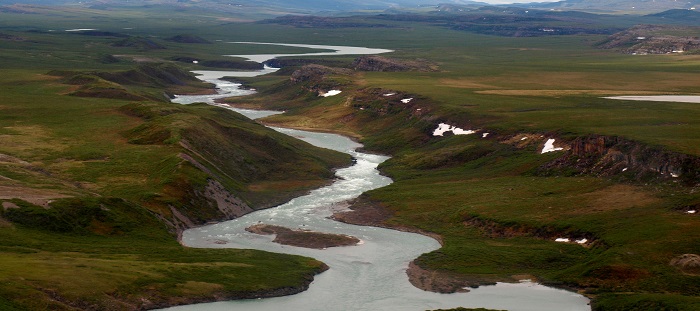
FOR THE PAST THREE DAYS, we have stayed at Plummer’s Lodge and fished Great Bear Lake – a massive freshwater reservoir in the Northwest Territories surrounded by an immensity of fir forests, swamps and barren plains. On the lake we have experienced some spectacularly good fly fishing for fierce lake trout in cannibalistic sizes, but throughout the whole ordeal the guides and guests have been talking excessively about another body of water: The Tree River, in the Nunavut Territory. Now, there’s obviously nothing controversial about fishermen talking longingly about other destinations than the one they’re currently fishing – no matter where that may be. But Tree River soon comes to sound like a place of special interest. It is talked about with an enthusiasm bordering on religious fanaticism – as if it was a mythological place from a long-gone era.
The guides and guests, who have previously visited Tree River, lighted up with blissful and devout looks on their faces, when Tree River came up in conversation. They pronounced the name with such respect that you’d think the name was sacred – and when the enthrallingly beautiful river’s record-sized arctic char are mentioned in passing, their eyes glisten and their voices come alive with a sudden, high-frequent eagerness.
The turquoise blue Tree River on the brink of the Arctic Ocean seems to have an almost bewitching effect on the people who travel there – these initiated individuals who nod knowingly to each other, when someone talks about swinging streamers in Presidential Pool, rising to the challenges of Second Fall’s whirling eddies, and spey-casting in Amsterdam’s deep runs. They all seem to lack words to describe exactly what it is about the river that makes it so special, but their accounts were saturated with an incisive yearning and nostalgia.
We obviously had a hard time understanding all the hype, but when we heard that it was possible to charter a small hydroplane and fly out the river, it obviously didn’t take us long before we’re packed and ready to go.
AS THE HYDROPLANE touched down on Tree River’s lightly milk-coloured glacial water, we still had no idea about what awaits us. Here, downstream from the provisional Tree River Lodge, where we’ll be sleeping over, the river wasn’t something out of the ordinary. It meanders drowsily downstream towards the Arctic Ocean set down in a harsh and barren terrain, and it might as well have been any random river in Greenland or Northern Norway.
It wasn’t until we have unloaded all our equipment and supplies at the lodge, pieced our fly rods together and hiked upstream that the river really started to work its subtle magic on us. Up here, the river has an altogether different character and temperament. Radically different even! It is WILD! Up here the calm waters of the lower river was superseded by frothing white water that gushed purposefully downstream prompted by dramatic increases in terrain gradients. Here, the river was a roaring and intimidating force of nature. Riffles, eddies, and waterfalls were succeeded by maelstrom-like back waters, sheltering boulders and temporary windows of limpid water – all of it dangerously proximate to rushing currents with meter-high, foaming waves. In its upper reaches, Tree River was a truly chaotic and unbridled river – an intimidating but fascinatingly beautiful whirlpool of water that ripped and tore at our fast-beating hearts as we followed its course further upstream (frequently looking over our shoulders for grumpy grizzlies).
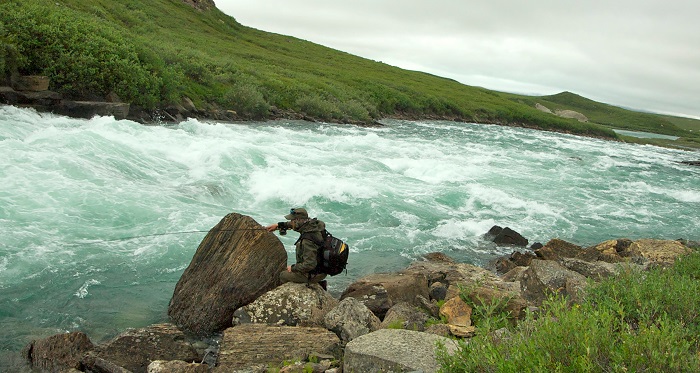
FOR THE NEXT 24 HOURS we thrust ourselves upon the river and its massive arctic char, and in the process our naivety and lack of tackle preparation was exposed and severely punished.
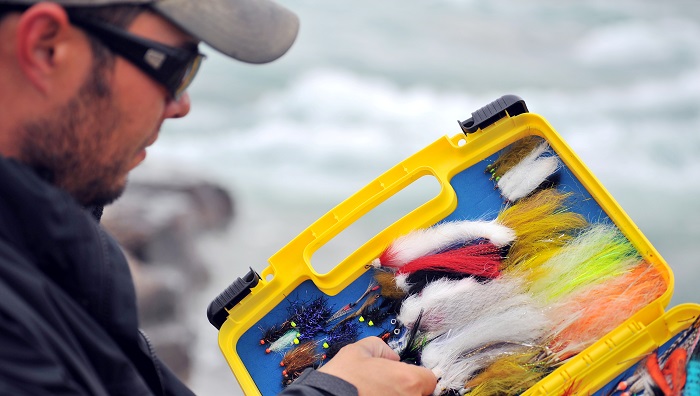
We have previously experienced prolonged trips with broken rods, failing equipment and spooled fly reels. However, what happened over the course of a single day at Tree River was almost tragicomic in comparison. In addition to burst leaders, broken links and straightened-out hooks we lost a shooting head, a full-length fly line and 50 metres of backing. And we broke two 8-weight rods into half. Granted, we started off by catching a stringer of insolently beautiful 4-5kgs arctic char in the Presidential Pool – a slightly insignificant pool that has gotten its name because George Bush Sr. likes to fish there. But as we charter further upstream and faced the challenges of Relay Pool, Slippery Jack, Montreal and Second Falls, we suddenly felt as if we’re hunting buffaloes with slingshots. And we cursed ourselves for leaving the 10 and 11-weight rods at the Great Bear Lodge.
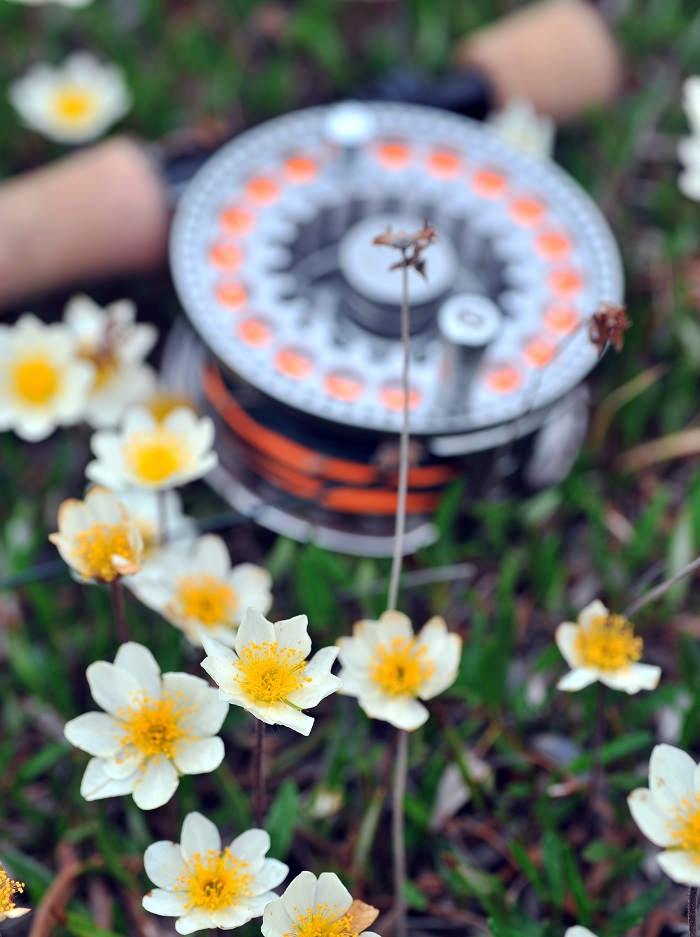
Not surprisingly, the combination of a river with torrential currents, steep banks, waterfalls and myriads of partially exposed boulders on the one hand and some explosive, strong-willed and more or less incontrollable arctic char on the other resulted in some over-dramatic fights. It was simply extreme! And to even stand the slightest chance, the fish must be fought mercilessly. The crux of the matter was to prevent them from reaching the frothing and waterslide-like main current and simply disappearing downstream. If that happened, all was lost. Pursuit was impossible, so all that’s left was to block the reel and hope that it was the leaders and not the fly line that frays and breaks; we were only halfway successful in this regard.
UNDER A LIGHTLY GRIZZLED SKY, lit subtly by the midnight sun’s lazy gloom, we experienced some fishing that by far exceeded our wildest expectations. We have been fortunate enough to hit one of the season’s first considerable runs of arctic char, and after sufficient experimentation with different line densities, flies, and techniques we started making contact with one fully-grown char after the other. The majority of them – including a small handful of fish that must have been shockingly close to the magic 20lb mark – we lost, but that’s beside the point.
The statistics notwithstanding, we caught more and bigger arctic char than most uninitiated people would immediately be inclined to believe, and every dramatic and nerve-wracking fight left its own indelible impression in us.
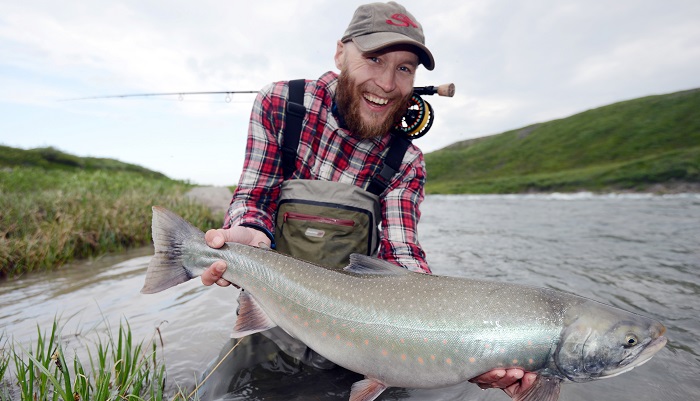
Along the way, we both lost all sense of time. We were right on the edge of the end of the world, on the bank of an intoxicatingly beautiful river, but we were both painfully aware that we were here on borrowed time. And the thought that we had to leave this paradise on earth made us fish with equally dosed amounts of focus and fright – as if every cast might be the last.
At one point during the night, Klaus broke his fly rod on a chrome beauty just shy of eight kilos – a fish he miraculously landed despite the accident. After that, we took turns fighting and landing fish. Then my fly rod snapped too – with a loud whiplashing sound! The sudden crack woke us up – as if from a dream. The river poured downstream with renewed intensity, the beautiful tundra came back to life with vivid colours, and all of a sudden we were awkwardly aware of the surroundings and ourselves. We have now broken both the treacherous wands that we have been flinging subconsciously over the river all day, and a spell has been broken. The river has set us free, and even though it might have been tempting to hike the rough five kilometres back to the camp to pick up the backup rods, there seemed to be no point in doing so.
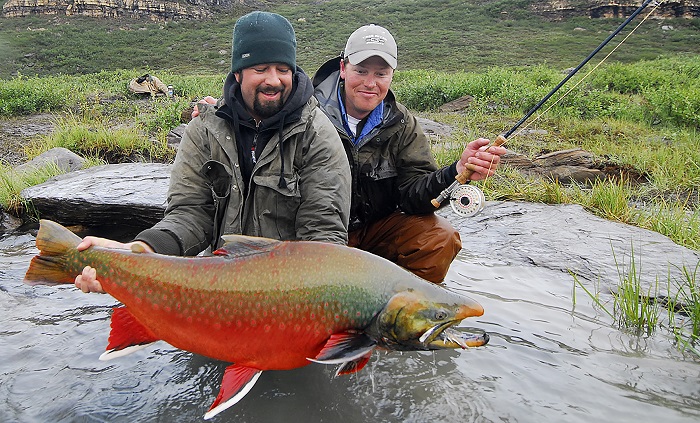
All day, we have willingly let ourselves become seduced and enraptured by the river’s promises of record-sized arctic char, and we have quietly lost ourselves in all the hectic activity. Now that we have journeyed back to the camp – full of impressions and as quiet as a couple of staunch believers in church, something far more comprehensive and essential intrudes. Neither of us can pinpoint exactly what it is, but it is something far more significant than the sum of the fish we have caught – something seminal and epochal. The river has changed us, and its indomitable willpower and life nerve is now within our hearts.
THE HYDROPLANE LEFT THIS MORNING and there are no guarantees that I will ever see Tree River again. But as I crept into my sleeping bag, closed my eyes and waited for sleep to overpower me, I am certain that, somehow, the river’s furtive magic will haunt me for the rest of my life. I too have lost my heart to Tree River!
FACT BOX:
TREE RIVER (Kogluktualuk) is a glacial river in the northwestern corner of the Canadian state, Nunavut. The river pours into Coronation Gulf, which is a part of the frigid Arctic Ocean to the high north. The lower stretches of the river are fairly chaotic with gushing white water, whirling pools, waterfalls and long riffles.
10 kilometres from the ocean there is a natural barrier for the arctic char’s spawning run, which occurs over the course of the summer – from the middle of June through September. The barrier is a plummeting and several metre-high waterfall that is impossible for the fish to climb. Downstream, the river gets packed to the bursting point with fully-grown arctic char, which become increasingly coloured up as the season progresses.
Tree River Lodge provides access to the upper four kilometres of the lower river stretches. From the lodge itself you hike upstream from one pool to the next, or you fish from a boat or spey cast in some of the bigger and more slow-flowing pools close to – and below the lodge. The fishery is administered by Plummers’s Arctic Lodges in cooperation with the local Indian tribe. The season is short and hectic – just like the arctic summer, and it runs from the beginning of July through August. However, because of the midnight sun, you can fish 24 hours a day. Additional information can be found here: http://www.plummerslodges.com/lodges/tree-river
FACT BOX:
THE ARCTIC CHAR in Tree River are the world’s largest, and the majority of all existing world records stem from this river. This, for instance, is the case with two notable line records, the fly fishing record, and – last but not least – the biggest arctic char ever landed on a rod and reel: a giant of 14.77kgs.
Presumably, there are several good explanations as to why the Tree River arctic char grow to such incredible sizes. They have ample amounts of prey fish to feed on in the Arctic Ocean and in the estuary of the river, plus there’s an extreme form of natural selection in play when it comes to the spawning. In effect, only the biggest and most powerful fish are capable of climbing the many waterfalls and torrential currents. A more weighty argument, however, is probably that the Tree River arctic char are of mixed blood. There are lake char in the river too, and throughout the ages hybridization must have occurred.
New investigations have proven that the Tree River arctic char have traces of lake char DNA in their genetic codes, and genes from lake char – a species that grows to 35-40 kilos, might explain how the Tree River arctic char get to be so enormous compared to other strains.

